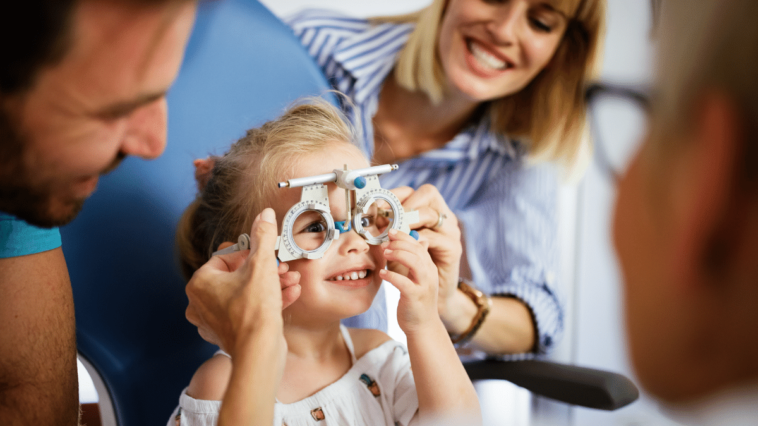Good vision is essential for children’s development and learning. Children rely on their eyes to explore and learn about the world around them. Pay attention to your child’s vision and eye health and address any issues as early as possible.
Know the Signs of Vision Problems in Children.
Several signs may indicate a vision problem in children. It is essential to be aware of these signs and to seek a professional evaluation if you notice any of them in your child. Some common symptoms of vision problems in children include:
Squinting or eye rubbing: Children may squint or rub their eyes if they have trouble seeing clearly.
Headaches: Children may experience headaches if they are straining to see.
Poor performance in school: Children may have difficulty reading or completing other visual tasks if they have a vision problem.
Difficulty following a moving object: Children may have difficulty tracking a moving object with their eyes if they have a vision problem.
Holding objects close to the face: Children may hold things close to their faces to see them more clearly if they have a vision problem.
Tilting the head: Children may tilt their heads to see better if they have a vision problem.
Sensitivity to light: Children may be sensitive to bright lights or glare if they have a vision problem.
If you notice any of these signs in your child, it is essential to have their vision evaluated by an eye care professional. Early detection and treatment of vision problems can help children achieve their full potential and prevent long-term vision problems.
Understand How to Choose the Right Eyewear for Your Child.
There are several factors to consider when choosing eyewear for your child. Here are some tips to help you choose the correct eyewear for your child:
Consult an eye care professional: An eye care professional can help you determine the type of eyewear best for your child’s specific vision needs. They can also help you choose frames that are the appropriate size and shape for your child’s face.
Consider your child’s lifestyle: Consider your child’s activities and hobbies when choosing eyewear. For example, choose more durable frames with shatter-resistant lenses if your child is active and plays sports.
Choose frames that fit well: It is important to choose frames that are comfortable for your child. Frames that are too loose or too tight can be uncomfortable and may cause problems with vision.
Look for adjustable features: Some frames have flexible features, such as adjustable nose pads or temples, which can help ensure a more comfortable and secure fit.
Consider your child’s preferences: It is essential to involve your child in the eyewear selection process and consider their preferences. This can help ensure that they are more likely to wear eyewear consistently.
Protect your investment: Make sure to protect your investment by purchasing eyewear with scratch-resistant and UV-protective lenses. These features ensure that the eyewear lasts longer and provides adequate protection for your child’s eyes.
These tips can help ensure your child has the best eyewear for their specific vision needs and lifestyle.
Learn About Vision Screenings and Tests for Kids.
Vision screenings and tests are essential tools for detecting vision problems in children. Early detection and treatment of vision problems can help children achieve their full potential and prevent long-term vision problems.
Several types of vision screenings and tests can be used to evaluate a child’s vision. These include:
Visual acuity test: This test measures how well a child can see at different distances. It is usually done using a chart with letters or symbols that get smaller as they get farther down the chart. The child is asked to read the letters or symbols out loud, and the smallest line they can read accurately is recorded as their visual acuity.
Eye muscle test: This test checks the movement and coordination of the eyes. The child is asked to follow a moving object or a light with their eyes.
Cover test: This test checks for the misalignment of the eyes. The child is asked to cover one eye and look at an object with the other eye. The eye care professional then covers the other eye and checks for any movement or misalignment of the uncovered eye.
Refraction test: This test measures the lens power needed to correct a child’s vision. It is usually done using a phoropter machine with a series of lenses the child looks through while reading a chart.
Ocular health evaluation: This test checks for any problems with the eyes themselves, such as cataracts or abnormalities of the eye structures.
Having your child’s vision regularly evaluated is essential to ensure that any vision problems are detected and treated as early as possible. Vision screenings and tests are usually performed by an eye care professional, such as an optometrist or ophthalmologist. Sometimes, a primary care provider or school nurse may conduct vision screenings.
Discover How to Protect Your Child’s Eyes from Damage.
You can take several steps to protect your child’s eyes from damage. Here are some tips to help protect your child’s eyes:
Please encourage your child to wear protective eyewear: Encourage them to wear it when participating in activities that pose a risk to their eyes, such as sports or working with power tools.
Protect your child’s eyes from the sun: Make sure your child wears sunglasses that block out 99-100% UVA and UVB rays outdoors.
Keep household chemicals out of reach: Keep household chemicals, such as cleaning products and pesticides, out of reach of children to prevent accidental eye injuries.
Use computer screens and other screens responsibly: Encourage your child to take frequent breaks when using screens and to sit at a comfortable distance from the screen to prevent eye strain.
Get your child’s eyes checked regularly: It is essential to have your child’s eyes checked by an eye care professional regularly to ensure that any vision problems are detected and treated as early as possible.
These tips can help protect your child’s eyes from damage and maintain healthy vision.
Get Specific Tips on Helping Children with Low Vision Issues.
If your child has low vision, there are several steps you can take to help them manage their vision and improve their quality of life. Here are some specific tips for helping children with low vision issues:
Encourage your child to use assistive devices: There are many assistive devices available that can help children with low vision see more clearly, such as magnifiers, video magnifiers, and electronic reading aids. Encourage your child to use these devices and find the best ones.
Please help your child learn coping strategies: Children with low vision may need different techniques to complete everyday tasks, such as using touch to identify objects or their peripheral vision to navigate. Please help your child learn these coping strategies and practice using them.
Please encourage your child to participate in activities: Children with low vision need to stay active and engaged in activities they enjoy. Please encourage your child to participate in activities appropriate for their vision level and offer assistance as needed.
Make your home more accessible: There are many ways you can make your home more accessible for a child with low vision. This may include installing bright and evenly distributed lighting, using contrasting colors to help objects stand out, and providing large print materials.
Seek support: It can be helpful to connect with other families who are also dealing with low vision issues. Many support groups and resources available can provide information and support to families of children with low vision.
By following these tips, you can help your child with low vision manage their vision and improve their quality of life. Working closely with an eye care professional to determine the best treatment options for your child’s specific vision needs is also essential.






